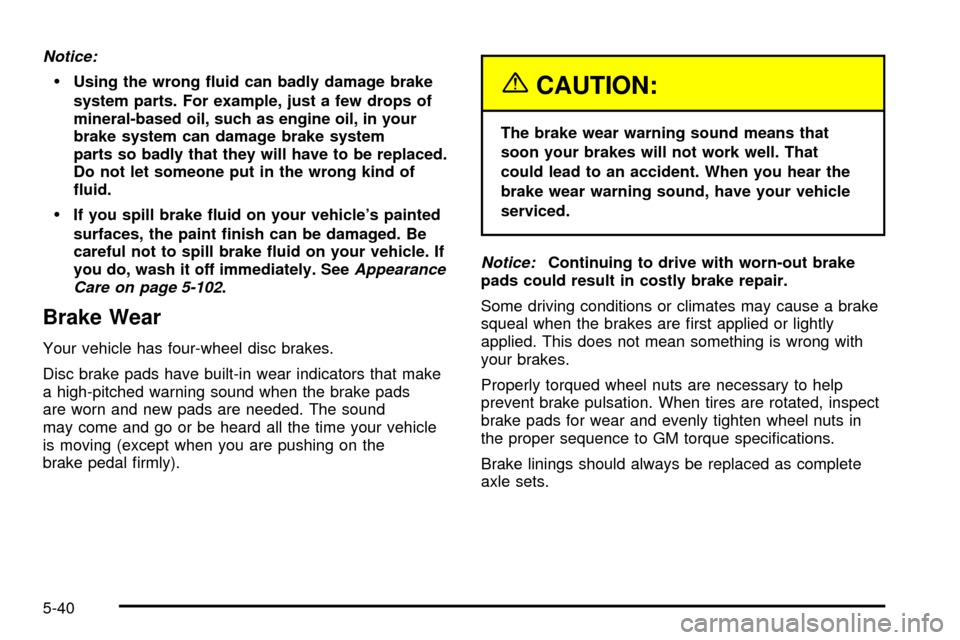warning light CADILLAC ESCALADE EXT 2004 2.G Owner's Manual
[x] Cancel search | Manufacturer: CADILLAC, Model Year: 2004, Model line: ESCALADE EXT, Model: CADILLAC ESCALADE EXT 2004 2.GPages: 478, PDF Size: 3.43 MB
Page 332 of 478

Engine Coolant
The cooling system in your vehicle is ®lled with
DEX-COOLžengine coolant. This coolant is designed
to remain in your vehicle for 5 years or 150,000 miles
(240 000 km), whichever occurs ®rst, if you add
only DEX-COOL
žextended life coolant.
The following explains your cooling system and how to
add coolant when it is low. If you have a problem
with engine overheating, see
Engine Overheating on
page 5-26.A 50/50 mixture of clean, drinkable water and
DEX-COOL
žcoolant will:
·Give freezing protection down to-34ÉF (-37ÉC).
·Give boiling protection up to 265ÉF (129ÉC).
·Protect against rust and corrosion.
·Help keep the proper engine temperature.
·Let the warning lights and gages work as they
should.
Notice:Using coolant other than DEX-COOLžmay
cause premature engine, heater core or radiator
corrosion. In addition, the engine coolant may
require changing sooner, at 30,000 miles (50 000 km)
or 24 months, whichever occurs ®rst. Any repairs
would not be covered by your warranty. Always use
DEX-COOL
ž(silicate-free) coolant in your vehicle.
5-22
Page 350 of 478

Notice:
·Using the wrong ¯uid can badly damage brake
system parts. For example, just a few drops of
mineral-based oil, such as engine oil, in your
brake system can damage brake system
parts so badly that they will have to be replaced.
Do not let someone put in the wrong kind of
¯uid.
·If you spill brake ¯uid on your vehicle's painted
surfaces, the paint ®nish can be damaged. Be
careful not to spill brake ¯uid on your vehicle. If
you do, wash it off immediately. See
Appearance
Care on page 5-102.
Brake Wear
Your vehicle has four-wheel disc brakes.
Disc brake pads have built-in wear indicators that make
a high-pitched warning sound when the brake pads
are worn and new pads are needed. The sound
may come and go or be heard all the time your vehicle
is moving (except when you are pushing on the
brake pedal ®rmly).
{CAUTION:
The brake wear warning sound means that
soon your brakes will not work well. That
could lead to an accident. When you hear the
brake wear warning sound, have your vehicle
serviced.
Notice:Continuing to drive with worn-out brake
pads could result in costly brake repair.
Some driving conditions or climates may cause a brake
squeal when the brakes are ®rst applied or lightly
applied. This does not mean something is wrong with
your brakes.
Properly torqued wheel nuts are necessary to help
prevent brake pulsation. When tires are rotated, inspect
brake pads for wear and evenly tighten wheel nuts in
the proper sequence to GM torque speci®cations.
Brake linings should always be replaced as complete
axle sets.
5-40
Page 382 of 478

Tire Pressure Monitor System
The Tire Pressure Monitor (TPM) system uses radio
and sensor technology to check tire pressure levels. If
your vehicle has this feature, sensors are mounted
on each tire and wheel assembly, except the spare tire.
The TPM sensors transmit tire pressure readings to
a receiver located in the vehicle.
When a low tire pressure condition is detected, the TPM
system will display the CHECK TIRE PRESSURE
warning message on the Driver Information Center
(DIC); and at the same time illuminate the low tire
pressure warning symbol. For additional information and
details about the DIC operation and displays see DIC
Operation and Displays on page 3-49andDIC Warnings
and Messages on page 3-60.
When the tire pressure
monitoring system warning
light is lit, one or more
of your tires is signi®cantly
under-in¯ated.You should stop and check your tires as soon as
possible, and in¯ate them to the proper pressure as
indicated on the vehicle's tire information placard.
Driving on a signi®cantly under-in¯ated tire causes the
tire to overheat and can lead to tire failure.
Under-in¯ation also reduces fuel efficiency and tire tread
life, and may affect the vehicle's handling and stopping
ability. Each tire, including the spare, should be
checked monthly when cold and set to the
recommended in¯ation pressure as speci®ed in the
vehicle placard and owner's manual.
The Certi®cation/Tire label or the Tire and Loading
Information label (tire information placard) shows the
size of your vehicle's original tires and the correct
in¯ation pressure for your vehicle's tires when they are
cold. SeeIn¯ation - Tire Pressure on page 5-71. For
the location of the tire and loading information label, see
Loading Your Vehicle on page 4-47.
Your vehicle's TPM system can alert you about a low
tire pressure condition but it does not replace normal tire
maintenance. See
Tire Inspection and Rotation on
page 5-74andTires on page 5-63.
Notice:Do not use a tire sealant if your vehicle is
equipped with Tire Pressure Monitors. The liquid
sealant can damage the tire pressure monitor
sensors.
5-72
Page 383 of 478

TPM Sensor Identi®cation Codes
Each TPM sensor has a unique identi®cation code. Any
time you rotate your vehicle's tires or replace one or
more of the TPM sensors, the identi®cation codes
will need to be matched to the new tire/wheel position.
Each tire/wheel position is matched to a sensor, by
increasing or decreasing the tire's air pressure.
The sensors are matched to the tire/wheel positions in
the following order: left front (LF); right front (RF);
right rear (RR) and left rear (LR).
You will have one minute to match the ®rst tire/wheel
position, and ®ve minutes overall to match all four
tire/wheel positions. If it takes longer than one minute,
to match the ®rst tire and wheel, or more than ®ve
minutes to match all four tire and wheel positions the
matching process stops and you will need to start over.
The TPM sensor matching process is outlined below:
1. Set the Parking brake.
2. Turn the ignition switch to RUN with the engine off.3. Turn the exterior lamp switch from ªOffº to ªOnº
four times within 3 seconds. A double horn chirp
will sound and the TPM low tire warning light
will begin to ¯ash. The double horn chirp and
¯ashing TPM warning light indicate that the TPM
matching process has started. The TPM warning
light should continue ¯ashing throughout the
matching procedure. The SERVICE TIRE
MONITOR message will be displayed on the Driver
Information Center (DIC).
4. Start with the left (driver's side) front tire.
5. Remove the valve cap from the valve cap stem.
Activate the TPM sensor by increasing or
decreasing the tire's air pressure for 10 seconds,
then stop and listen for a single horn chirp.
The single horn chirp should sound within
15 seconds, con®rming that the sensor identi®cation
code has been matched to this tire and wheel
position. If you do not hear the con®rming single
horn chirp, you will need to start over with step
number one. To let air-pressure out of a tire you can
use the pointy end of the valve cap, a pencil-style
air pressure gage or a key.
5-73
Page 384 of 478

6. Proceed to the right (passenger's side) front tire,
and repeat the procedure in step 5.
7. Proceed to the right (passenger's side) rear tire,
and repeat the procedure in step 5.
8. Proceed to the left (driver's side) rear tire, and
repeat the procedure in step 5.
9. After hearing the con®rming horn chirp for the left
rear tire, check to see if the TPM warning light is
still ¯ashing. If yes, turn the ignition switch to OFF.
10. Set all four tires to the recommended air pressure
level as indicated on the Certi®cation/Tire label or
the Tire and Loading Information label.
11. Put the valve caps back on the valve stems
The spare tire does not have a TPM sensor. If you
replace one of the road tires with the spare, the CHECK
TIRE PRESSURE message will be displayed on the
DIC screen. This message should go off once you
re-install the road tire containing the TPM sensor. The
SERVICE TIRE MONITOR message is displayed
when the TPM system is malfunctioning. One or more
missing or inoperable TPM sensors will cause the
service tire monitor message to be displayed. See your
dealer for service.Federal Communications Commission and
Industry and Science Canada
The TPM system operates on a radio frequency subject
to Federal Communications Commission (FCC) Rules
and with Industry and Science Canada.
This device complies with Part 15 of the FCC Rules and
with RSS-210 of Industry and Science Canada.
Operation is subject to the following two conditions: (1)
This device may not cause harmful interference, and
(2) this device must accept any interference received
including interference that may cause undesired
operation of the device.
Changes or modi®cations to this system by other than
an authorized service facility could void authorization to
use this equipment.
Tire Inspection and Rotation
Tires should be rotated every 5,000 to 8,000 miles
(8 000 to 13 000 km).
Any time you notice unusual wear, rotate your tires as
soon as possible and check wheel alignment. Also
check for damaged tires or wheels. See
When It Is Time
for New Tires on page 5-76andWheel Replacement
on page 5-80for more information.
5-74
Page 388 of 478

Uniform Tire Quality Grading
Quality grades can be found where applicable on the
tire sidewall between tread shoulder and maximum
section width. For example:
Treadwear 200 Traction AA Temperature A
The following information relates to the system
developed by the United States National Highway
Traffic Safety Administration, which grades tires by
treadwear, traction and temperature performance. (This
applies only to vehicles sold in the United States.)
The grades are molded on the sidewalls of most
passenger car tires. The Uniform Tire Quality Grading
system does not apply to deep tread, winter-type
snow tires, space-saver or temporary use spare tires,
tires with nominal rim diameters of 10 to 12 inches
(25 to 30 cm), or to some limited-production tires.
While the tires available on General Motors passenger
cars and light trucks may vary with respect to these
grades, they must also conform to federal safety
requirements and additional General Motors Tire
Performance Criteria (TPC) standards.
Treadwear
The treadwear grade is a comparative rating based on
the wear rate of the tire when tested under controlled
conditions on a speci®ed government test course.
For example, a tire graded 150 would wear one and
a half (1.5) times as well on the government course as
a tire graded 100. The relative performance of tires
depends upon the actual conditions of their use,
however, and may depart signi®cantly from the norm
due to variations in driving habits, service practices and
differences in road characteristics and climate.
Traction ± AA, A, B, C
The traction grades, from highest to lowest, are AA, A,
B, and C. Those grades represent the tire's ability
to stop on wet pavement as measured under controlled
conditions on speci®ed government test surfaces of
asphalt and concrete. A tire marked C may have poor
traction performance. Warning: The traction grade
assigned to this tire is based on straight-ahead braking
traction tests, and does not include acceleration,
cornering, hydroplaning, or peak traction characteristics.
5-78
Page 461 of 478

A
Accessory Power Outlets.................................3-23
Adding Washer Fluid.......................................5-37
Additional Program Information........................... 7-8
Additives, Fuel................................................. 5-5
Add-On Electrical Equipment...........................5-111
Add-On Equipment..........................................4-53
Adjustable Throttle and Brake Pedal..................2-32
Adjusting the Speakers (Balance/Fade)..............3-72
After Off-Road Driving.....................................4-30
Air Bag
Passenger Status Indicator...........................3-36
Readiness Light..........................................3-36
Air Bag Systems.............................................1-48
Adding Equipment to Your Air Bag-Equipped
Vehicle...................................................1-60
How Does an Air Bag Restrain?....................1-54
Passenger Sensing System...........................1-56
Servicing Your Air Bag-Equipped Vehicle.........1-60
What Makes an Air Bag In¯ate?....................1-53
What Will You See After an Air Bag
In¯ates?..................................................1-54
When Should an Air Bag In¯ate?...................1-52
Where Are the Air Bags?..............................1-50Air Cleaner/Filter, Engine.................................5-16
Air Conditioning..............................................3-29
Airbag Sensing and Diagnostic Module (SDM)...... 7-8
All-Wheel Drive...............................................5-48
All-Wheel Drive (AWD) System.........................2-36
AM .............................................................3-100
Analog Clock..................................................3-24
Antenna, Fixed Mast......................................3-102
Antenna, XMŸ Satellite Radio Antenna
System.....................................................3-102
Anti-lock Brake System..................................... 4-7
Anti-Lock Brake System Warning Light...............3-41
Appearance Care..........................................5-102
Care of Safety Belts...................................5-105
Chemical Paint Spotting..............................5-108
Cleaning the Inside of Your Vehicle..............5-103
Cleaning the Outside of Your Vehicle............5-105
Finish Damage..........................................5-108
Sheet Metal Damage..................................5-108
Underbody Maintenance.............................5-108
Vehicle Care/Appearance Materials...............5-109
Weatherstrips............................................5-105
Approaching a Hill..........................................4-22
Ashtrays........................................................3-23
Audio Output..................................................3-91
1
Page 462 of 478

Audio System(s).............................................3-67
Audio Steering Wheel Controls......................3-99
Care of Your Cassette Tape Player...............3-100
Care of Your CD and DVD Player................3-102
Care of Your CD Changer...........................3-101
Care of Your CDs and DVDs.......................3-101
CD Changer...............................................3-95
Chime Level Adjustment.............................3-102
Fixed Mast Antenna...................................3-102
Navigation/Radio System..............................3-82
Radio with Cassette and CD.........................3-68
Rear Seat Audio (RSA)................................3-94
Setting the Time..........................................3-68
Theft-Deterrent Feature................................3-98
Understanding Radio Reception...................3-100
XMŸ Satellite Radio Antenna System...........3-102
Automatic Climate Control System.....................3-24
Automatic Dimming Mirror Operation..................2-44
Automatic Headlamp System............................3-16
Automatic Level Control...................................4-54
Automatic Transmission
Fluid..........................................................5-19
Operation...................................................2-34B
Backing Up....................................................4-62
Battery..........................................................5-41
BATTERY NOT CHARGING.............................3-61
Battery Replacement......................................... 2-6
Battery Run-Down Protection............................3-20
Before Leaving on a Long Trip.........................4-37
Before You Drive............................................3-83
Before You Go Off-Roading..............................4-17
Brake
Parking......................................................2-37
System Warning Light..................................3-39
Brake Adjustment............................................5-41
Brake Fluid....................................................5-38
Brake Pedal, Throttle.......................................2-32
Brake Pedal Travel.........................................5-41
Brake Wear...................................................5-40
Brakes..........................................................5-38
Braking........................................................... 4-6
Braking in Emergencies..................................... 4-8
Break-In, New Vehicle.....................................2-29
BUCKLE PASSENGER....................................3-64
BUCKLE SEATBELT.......................................3-64
2
Page 467 of 478

F
Filter
Engine Air Cleaner......................................5-16
Finding a Program Type (PTY) Station
(RDS and XMŸ).........................................3-72
Finding a Station............................................3-70
Finish Care..................................................5-106
Finish Damage.............................................5-108
Fixed Mast Antenna.......................................3-102
Flash-to-Pass................................................... 3-9
Flat Tire........................................................5-82
Flat Tire, Changing.........................................5-83
Fluid
Automatic Transmission................................5-19
Power Steering...........................................5-35
Windshield Washer......................................5-36
FM Stereo....................................................3-100
Fog Lamps....................................................3-18
Following Distance..........................................4-62
Front Axle......................................................5-50
Fuel............................................................... 5-4
Additives...................................................... 5-5
California Fuel.............................................. 5-5
Filling a Portable Fuel Container..................... 5-8
Filling Your Tank........................................... 5-6
Fuels in Foreign Countries.............................. 5-6
Gage.........................................................3-48
Gasoline Octane........................................... 5-4Fuel (cont.)
Gasoline Speci®cations.................................. 5-5
Low Warning Light.......................................3-48
Fuel Information Button....................................3-52
FUEL LEVEL LOW.........................................3-62
Fuses
Fuses and Circuit Breakers.........................5-111
Windshield Wiper.......................................5-111
G
Gage
Engine Coolant Temperature.........................3-42
Fuel..........................................................3-48
Oil Pressure...............................................3-46
Speedometer..............................................3-35
Tachometer.................................................3-35
Transmission Temperature.............................3-43
Voltmeter Gage...........................................3-39
Garage Door Opener.......................................2-50
Gasoline
Octane........................................................ 5-4
Speci®cations............................................... 5-5
Gate Operator and Canadian Programming........2-52
Getting Familiar with Off-Road Driving................4-20
Glove Box.....................................................2-54
GM Mobility Program for Persons with
Disabilities.................................................... 7-5
7
Page 468 of 478

H
Hazard Warning Flashers................................... 3-6
Head Restraints............................................... 1-5
Headlamp
Aiming.......................................................5-51
Horizontal Aiming.........................................5-52
Vertical Aiming............................................5-53
Headlamp High/Low-Beam Changer.................... 3-9
Headlamps....................................................5-56
Bulb Replacement.......................................5-55
Front Turn Signal, Sidemarker and Daytime
Running Lamps........................................5-60
Halogen Bulbs............................................5-55
High Intensity Discharge (HID) Lighting...........5-55
Headphones...................................................3-89
Heated Seats................................................... 1-3
Heating.........................................................3-30
Highway Hypnosis...........................................4-38
Hill and Mountain Roads..................................4-38
Hitches..........................................................4-60
HomeLink
žTransmitter....................................2-50
HomeLinkžTransmitter, Programming................2-50
Hood
Checking Things Under.................................. 5-8
Release....................................................... 5-9
Horn............................................................... 3-7
How the System Works...................................3-22
How to Add Coolant to the Coolant
Surge Tank.................................................5-30How to Add Fluid............................................5-21
How to Check........................................5-19, 5-71
How to Check Lubricant...................................5-49
How to Check Power Steering Fluid..................5-36
How to Inspect...............................................5-17
How to Use This Manual...................................... ii
How to Wear Safety Belts Properly...................1-14
Hydroplaning..................................................4-34
I
If No Steam Is Coming From Your Engine..........5-27
If Steam Is Coming From Your Engine...............5-26
If the Light is Flashing.....................................3-45
If the Light Is On Steady.................................3-45
If You Are Caught in a Blizzard.........................4-42
If You Are Stuck in Sand, Mud, Ice or Snow.......4-44
If You Do Decide To Pull A Trailer.....................4-56
Ignition Positions.............................................2-30
Illuminated Visor Vanity Mirrors.........................2-27
Infants and Young Children, Restraints...............1-30
In¯ation - Tire Pressure...................................5-71
Instrument Panel
Cluster.......................................................3-34
Overview..................................................... 3-4
Instrument Panel Brightness.............................3-19
Instrument Panel Fuse Block..........................5-112
Interior Lamps................................................3-19
8